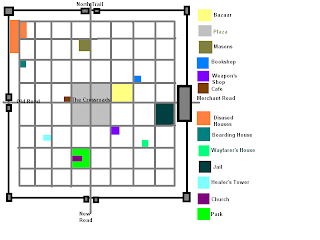The problem appears to me to be, as with the conversion of currency in the real world, the perceived value. In OSR games value is short-handed into the metal each coin is made from. But this seems faintly ludicrous for the purpose of FLAILSNAILS. I feel that the inherent value of the coins should remain roughly the same when moving between FLAILSNAILS worlds. Inherent value is measured in buying power, that is how much you can buy with them. In Jeff Rient's Wessex, a Gold Standard setting, a single gold coin buys exactly the same as a single silver coin does in Evan Elkins's Dark Country, a Silver Standard setting.
Where I am going with this is to suggest that perhaps what we should to do is separate the coins from the pre-defined value, what they're made from, and instead define the coins by what they're worth. The easiest way I can see to do this is to remove the metals from the names of the coins and instead name the coins as something other than "pieces".
Here's the coinage I intend to use in Fort Flaime:
- Sovereign: Bars of precious or semi-precious metals that are used to store wealth or trade between nations. Could literally be a pound of silver. They are mostly found in the hands of monarchs and the super-rich. Hence their name.
= Platinum Pieces under a Silver Standard
= Multiple Platinum Pieces under a Gold Standard - Crown: Large denomination coins typically only used by nobles and merchants amongst themselves. This association with the aristocracy gives the coins their name.
= Gold Pieces under a Silver Standard
= Platinum Pieces under a Gold Standard - Standard: These are amongst the most common coins used.At least by Adventurers. Weapons and armour typically cost multiple Standards but not quite a Crown and the association with military equipment gives rise to the name "standard".
= Silver Pieces under a Silver Standard
= Gold Pieces under a Gold Standard - Groat: The groat is the most common coin in circulation. It is said that "a man can eat but for the want of a groat"; a day's worth of food for a person typically costs them about a groat. Indeed the groat is also a generic term for hulled grain that is used as the foundation of many meals. Perhaps this is the source of the name.
= Copper Pieces under a Silver Standard
= Silver Pieces under a Gold Standard - Bit: These are the coins used for smallest of purchases. They're called bits because they are literally fragments of other coins. If something is "not worth a groat" then it is probably worth a bit, at least to someone.
= Fragments of Copper Pieces under a Silver Standard
= Copper Pieces under a Gold Standard
Feel free to comment, hurl criticisms or rotten fruit.



